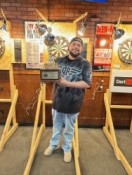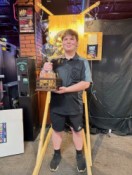TOURNAMENTS
2025 Singles Champs
Jeremy Miller (A Division)
Tommy Bantle (B Division)

Sam Zwilling (C Division)

A.D.O. Tournament Rules
Download the A.D.O. Tournament Rules handbook.
GLOSSARY OF TERMS
The following terms/meanings apply when used in the body of these Tournament Rules.
ADO: American Darts Organization
Bull: The center of the dartboard. See rules #23,45,47 and 56
Chalker: Scorekeeper
Leg/Game: That element of a Match recognized as a fixed odd number, i.e., 301/501/701/1001 or Cricket
Hockey: A line or toeboard marking the minimum throwing distance in front of the dartboard. See #16,17,18,59 and 60
Masculine: Masculine gender nouns or pronouns include female
Match: The total number of Legs in the competition between two players/teams
Singular: Singular terms, where necessary, include the plural
Turn: A Turn consists of three darts, unless a Leg/Match is completed in a lesser amount
PLAYING RULES
All darts events played under the exclusive supervision of and/or sanctioned by the ADO will be played in accordance with the following rules.
GENERAL
- Good Sportsmanship will be the prevailing attitude throughout the tournament.
- All players/teams will play by these Tournament Rules and, where necessary, any supplemental Rules stipulated by local Tournament Organizers.
- The interpretation of these Tournament Rules, in relation to a specific darts event, will rest with local Tournament Organizers, whose decisions shall be final and binding. Protests after the fact will not be considered.
- Any player/team who, during the course of any event, fails to comply with any of these Tournament Rules, will be subject to disqualification from that event.
- Gambling is neither permitted nor sanctioned by the ADO.
- The ADO will in the course of Tournament Sanctioning, ensure to the best of its ability, that the host/sponsor organization has the funding and/or sponsorship necessary to support the advertised cash prize structure for a darts event. The manner and matter of tournament prize payments are the responsibility of the respective host/sponsor organization and not that of the ADO.
- The ADO assumes no responsibility for accident or injury on the premises.
- The ADO reserves the right to add to or amend the ADO Tournament Rules at any time.
PROCEDURAL
- Decisions regarding the prize structure and event schedule, the method of player registration, and the choice of the match pairing system, are left at the discretion of local Tournament Organizers.
- Each player is entitled to (9) NINE practice darts at the assigned matchboard prior to a match. No other practice darts may be thrown during the match without the permission of the chalker.
- Tournament boards are reserved for assigned match pairings only. Boards are not to be used for practice, unless so designated by the Tournament Organizers.
- Match pairings will be called 3 times only (minimum of 5 minutes between calls). Should a player/team fail to report to the assigned board within the 15 minutes allotted time, a Forfeit will be called. NOTE: Should a player/team be called to matches in two concurrent events (i.e. a female in both Women’s only and an Open event), that player/team must choose in which event she/they wish to continue play. A Forfeit will be called, unless that player/team can reach their assigned board within the 15 minutes.
- Should a player’s equipment become damaged, or be lost during the course of a turn, that player will be allowed up to a maximum of 5 minutes in which to repair/replace the playing equipment.
- A maximum time limit of 5 minutes under exceptional circumstances, subject to the notification of the opponent and the chalker, will be allowed in the instance of a player requiring to leave the playing area during the course of matchplay.
- Opponents and chalkers ONLY are allowed inside the playing area.
- Opposing players must stand at least 2 feet behind the player at the hockey.
- Should a player have any portion of his feet or shoes over the hockey line during a turn, all darts so thrown will be counted as part of his turn, but any score made by said darts will be invalid and not counted. One warning by a tournament official will be considered sufficient before invoking this rule.
- A player wishing to throw a dart, or darts, from a point either side of the hockey must keep his feet behind an imaginary straight line extending from either side of the hockey.
TURN
- A Turn consists of three darts, unless a Leg/Match is completed in a lesser amount.
- All darts must be thrown by, and from, the hand. The player is allowed a total of 3 minutes to complete their turn as timed by a tournament official. No darts will be allowed to be thrown after 3 minutes.
- Should a player ‘touch’ any dart that is in the dartboard during a turn, that turn will be deemed to have been completed.
- A dart bouncing off or falling out of the dartboard, will not be rethrown.
STARTING AND FINISHING (ALL EVENTS)
- All Matches will begin with a coin flip to determine who has the option to throw 1st or 2nd at the Inner Bull. The player throwing closest to the Inner Bull will throw first in the 1st Leg. The Loser of the 1st Leg has the option of throwing for the Inner Bull first in the 2nd Leg. If the 3rd Leg is necessary, the Inner Bull will again be thrown, with the loser of the original coin flip having the option of throwing first.
- The second thrower may acknowledge the first dart as an Inner or Outer Bull and ask for that dart to be removed prior to his throw. Should the first dart be removed without the request of the 2nd thrower, a rethrow will occur; with the 2nd thrower now having the option of throwing first. The dart must remain the in the board in order to count. Additional throws may be made, until the player’s dart remains in the board. Should the 2nd thrower dislodge the dart of the 1st, a rethrow will be made with the 2nd thrower now throwing first. Rethrows shall be called if the chalker cannot decide which dart is closest to the Inner Bull, or if both darts are anywhere in the Inner Bull, or both darts are anywhere in the Outer Bull. The decision of the chalker is final. Should a rethrow be necessary, the darts will be removed and the person who threw 2nd will now throw 1st.
- For the purpose of starting and finishing a Leg/Match, the Inner Bull is considered a double 25.
STARTING AND FINISHING (DOUBLES/TEAM EVENTS)
- It is permissible for the Doubles/Team player finishing a Leg, to throw for the Inner Bull and start the subsequent Leg. It is also permissible for one member of a Doubles or Team to throw for the Inner Bull 1st, and have his partner or teammate shoot first in the leg.
- It is permissible for a Double or Team to participate with fewer than the required number of players, provided that the team forfeits a turn(s) in each rotation, equal to the number of missing players. The missing player(s) may NOT join a Leg in progress, but is allowed to participate in a subsequent Leg(s) of that Match.
- At the tournament director’s discretion, women may be recycled in mixed doubles and triples events only.
- No substitutes will be allowed after the first round of Doubles/Team play.
SCORING
- A scoreboard must be mounted within 4’ laterally from the dartboard and at not more than a 45-degree angle from the dartboard. It must be clearly visible in front of the player at the hockey.
- In all ADO sanctioned tournaments, you must have a chalker if one is available. If one is not available, the player must leave the darts in the board until the score is recorded.
- The chalker will mark the scores made in the outer columns of the scoreboard, and the totals remaining in the two middle columns.
- The chalker, if asked, may inform the thrower what he as scored and/or what he has left. He MAY NOT inform the thrower what he has left in terms of number combinations. It IS permissible for a partner, teammate, or a spectator to advise the thrower during the course of a Match. See #1.
- No dart may be touched by the thrower, another player, the chalker, or spectator, prior to the decision of the chalker.
- For a dart to score it must remain in the board 5 seconds after the 3rd or final dart has been thrown by that player. The tip of the dart point must be touching the bristle portion of the board.
- A dart’s score shall be determined from the side of the wire at which the point of the dart enters the wire segment.
- Should a dart lodge directly between the connecting wires on the dartboard, making it impossible to determine on which side of the wire the dart resides, the score shall always be the higher value of the two segments in question. This includes the outside double ring for the game shot. Determination as to whether the dart is directly between the wires will be made in accordance with rules #34 and #36.
- It is the responsibility of the player to verify his score before removing his darts from the board. The score remains as written if one or more darts has been removed.
- In Doubles/Team events, no player may throw (during a Leg) until each of his teammates has completed his turn. The FIRST player throwing out of turn will receive a score of zero points for that round and his Team will forfeit the turn.
ADDITIONAL '01' COMPETITION RULES
- Errors in arithmetic stand as written, unless corrected prior to the beginning of that player’s next turn. In case of Doubles/Team matches, such errors must be rectified prior to the next turn of any partner/player on that team.
- A Leg/Match is concluded at such time as a player/team hits the ‘double’ required to reduce their remaining score to zero, unless otherwise stated by the local Tournament Organizers. All darts thrown subsequently will not count for score.
- The ‘BUST RULE’ will apply. If the player scores one less, equal, or more points than needed to reach zero, he has "busted". His score reverts to the score required prior to the beginning of his turn.
- Fast finishes such as 3 in a bed, 222, 111, Shanghai, etc., do not apply.
ADDITIONAL 'CRICKET' COMPETITION RULES
- Cricket is played using the numbers 20, 19, 18, 17, 16, 15 and both the Inner and Outer Bull.
- To close a number, the player/team must score three of that number. The double and triple ring count as 2 or 3, respectively. Closure can be accomplished with three singles, a single and a double, or a triple.
- Once a player/team closes a number, he/they may score points on that number until the opponent also closes that number. The double and triple count as 2 or 3 times the numerical values, respectively. All numerical scores are added to the previous balance. Once both players/teams have scored three of a number, it is ‘closed’, and no further scoring can be made on that number by either player/team.
- To close the bull, the Outer Bull counts as a single, and the Inner Bull counts as a double.
- Numbers can be ‘owned’ or ‘closed’ in any order desired by the individual player/team. Calling your shot is not required.
- It shall be the responsibility of the player to verify his score before removing his darts from the board. The score remains as written if one or more darts has been removed from the board. In accordance with the inherent "strategy" involved in the Cricket game, corrections in arithmetic must be made before the next player throws. See #1.
- Winning the game:
- The player/team that closes all the numbers first and has the highest numerical score, will be declared the winner.
- If both sides are tied in points, or have no points, the first player/team to close the specified numbers will be the winner.
- If a player/team closes the numbers first, and is behind in points, he/they must continue to score on any number not closed until either the point deficit is made up, or the opponent has closed all the numbers.
EQUIPMENT
- Darts used in tournament play cannot exceed an overall maximum length of 30.5 cm (12 in.), nor weigh more than 50 gm per dart. Each dart will consist of a recognizable point, barrel, and flight.
- The dartboard will be a standard 18” bristle board, of the type approved by the ADO, and will be of the standard 1-20 clock pattern. A scoreboard is necessary, see rule #30.
- The scoring wedge indicated by 20 will be the darker of the two wedge colors and must be at the top center wedge.
- No alterations/accessories may be added to the board setups.
- The inner narrow band will score ‘Triple’ the segment number and the outer narrow band will score ‘Double’ the segment number.
- The outer center ring (Outer Bull) is scored at ‘25’ and the inner center ring (Inner Bull) is scored at ‘50’.
- The minimum throwing distance is 7’9¼”. The board height is 5’8” (floor to the center of the Inner Bull; 9’7-3/8” measured diagonally from the Inner Bull to the back of the raised hockey at floor level).
- Lights must be affixed in such a way as to brightly illuminate the board, reduce to a minimum the shadows cast by the darts, and not physically impede the flight of a dart.
- Whenever possible, a raised hockey, at least 1½” high and 2’ long, will be placed in position at the minimum throwing distance, and will measure from the back of the raised hockey 7’9¼” along the floor to a plumb line at the face of the dartboard.
- In the event the hockey is a tape or similar ‘flush’ marking, the minimum throwing distance is measured from the front edge of the tape closest to the dartboard.
